What if I told you there was a simple method to create an EASY and ACTIONABLE plan to go from a total social media newbie to having a booming online community surrounding your business?
Enter the social media content plan.
A social media content plan is a marketer’s overarching strategy to map out social media success.
It includes using best practices, the right platforms, carefully-selected topics, various tactics, and a content calendar.
This guide will show you my personal 15 tips to get more engagement, followers, and yes – sales.
We'll cover:
- 15 Tips for creating a successful social media content plan
- How to use Post Planner to automate your social media plan
- FAQ
15 Tips for creating a successful social media content plan
Using social media without laying down a strong foundation puts you on the fast track to failure.
The only problem is that many people feel lost when laying that foundation.
That’s what we’re here for.
In this section, we’ll show you 15 steps that’ll help you lay a strong foundation for social media success.
1. Set measurable goals and determine your KPIs
Before you start changing ANYTHING about your online presence, you need to decide EXACTLY what you hope to get from social media.
In other words, what do you want to see from your social media presence 6 months, a year, or 5 years from now?
Set yourself specific goals and determine how you’ll measure your success in those areas.
Here are some examples of common goals and objectives and some potential KPIs:
- More conversions from social media generated traffic
- Build connections with potential customers from social media engagement
- Increase brand awareness by increasing follower growth
A key component of setting social media goals is ensuring they’re measurable.
For example, “I want more DMs” is a measurable goal.
If you receive 50 DMs instead of 30, you succeeded.
On the other hand, “I’d like people to enjoy visiting my page more” isn’t a goal that's easy to measure.
However, knowing which metrics to monitor is KEY to understanding how well you’re doing.
To get a data-driven look at your social media progress, keep a close eye on these 4 areas:
- Follower growth
- Referral traffic
- Conversions
- Engagement
2. Define your ICP
By understanding your ICP, you can tailor content that resonates deeply with your target audience.
Defining your ICP involves several targeted steps:
- Determine demographic details like age, gender, socioeconomic status, etc.
- Identify pain points so you can tailor your content to address them.
- Work to understand their preferences and the things that repulse them.
Your ICP serves as your compass. Consider the customer journey that your ICP takes before making a purchase.
3. Study your competition
Hold your friends close, but hold your enemies closer, right?
It turns out that this saying holds true on social media. Studying your competitors is one of the best ways to learn how to improve your social media content.
In other words, you can figure out your social media weaknesses and identify your competitors’ strengths.
Then ask yourself these questions about your competition:
- What kind of content do they post?
- What topics do they post about?
- When do they post?
- How much engagement do they get?
- Who is their primary audience?
Understanding your competition’s strategy will help you differentiate yourself from them.
4. Audit your social media channels and content
The word “audit” is enough to send shudders down any tax-paying adult’s spine, but fortunately, we’re not talking about the IRS here.
Here’s how to perform a social media audit to improve your social media presence:
- Assess whether each social media channel you’re on is accomplishing its purpose.
- Go over your social content to make sure it matches up with your ICP (which you defined in Tip 2)
- Determine which types of contents are producing returns and which are a time suck.
- Ditch any social media channel or content style that’s not returning on your time investment.
But how do you decide which channels to keep and which to ditch?
Start by asking these 3 questions:
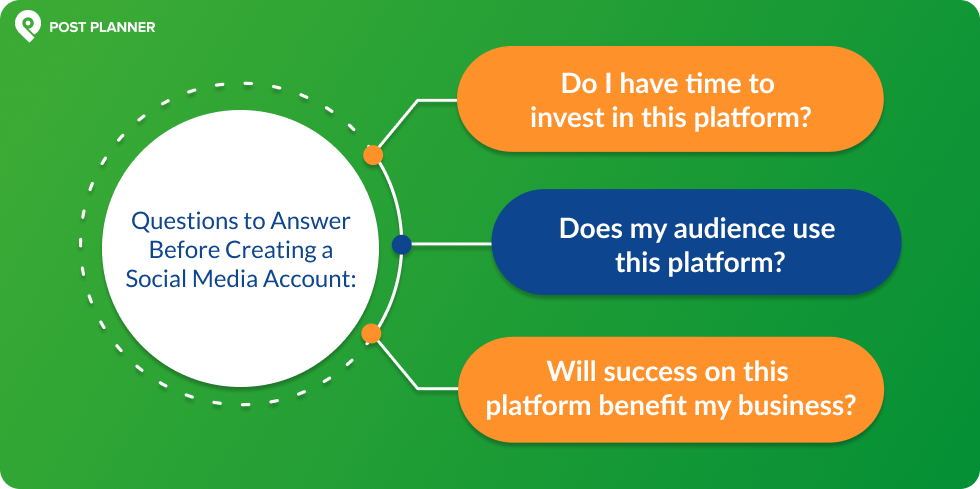
1. Is my audience on this channel?
If your audience is all 65-year-olds, you probably shouldn’t focus all your time on X (Twitter)! Older adults are one of the smallest demographics on X. Consider the demographic of your audience, then focus your efforts on the channels where they are.
2. Do I have time to invest in this channel (and would it be worth it to make time)?
If you’re actively focused on Instagram and YouTube, is it worth carving more time out of your schedule to invest in an extensive Facebook content campaign?
Only you can decide, but make that decision carefully so you don’t stretch yourself too thin.
3. Would success on this channel help my business grow?
You might be able to create a booming TikTok channel, but you should first consider whether doing so would generate more revenue for your business. If your ROI on TikTok is 10% of your ROI on Instagram, consider refocusing your efforts.
5. Optimize your social channels
Optimize your pages by fully completing your profiles.
These steps are easily (and frequently) overlooked:
- Are your bio sections filled out?
- Have you included links back to your site?
- Are attractive cover photos and profile pictures in place?
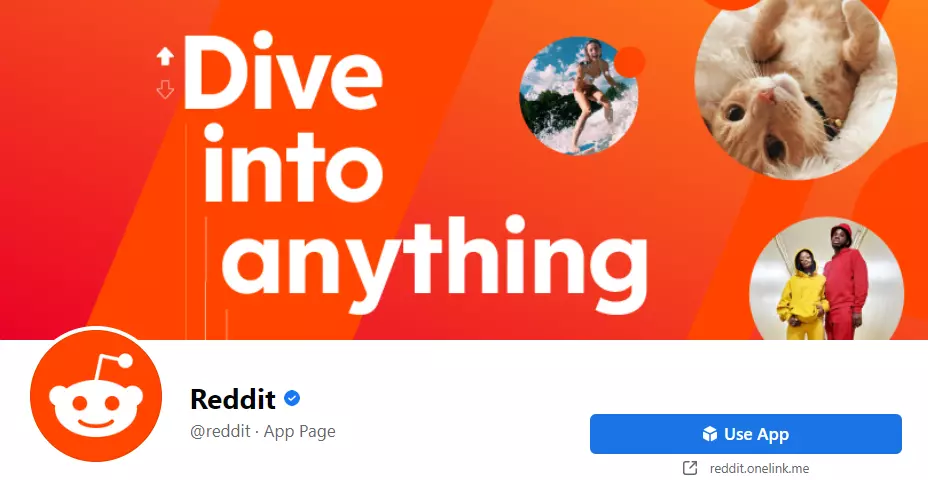
This seems simple, but many business owners lose out on potential traffic because they fail to ensure these basics are in place.
6. Map out topics according to your customer journey
You’ve already defined your ICP and their customer journey. It’s time to tailor content topics to address customer needs throughout that journey.
For example, let’s say you’ve determined 5 crucial points in your customer journey, and their focus will be slightly different at each point.
Your goal is to create content topics that allow you to target that specific point on the customer journey to help move that customer from this point to the next.
In addition to mapping out content topics, you should craft a call to action (CTA) for each topic. Your CTAs should guide users through the journey, prompting desired actions such as subscribing, downloading, or purchasing.
7. Plan content creation strategies
Now that you have your main topics planned out, you should start planning for some specific types of content.
In other words, what structures do you have in place to create the types of content you’ll include in your plan?
- Video
- Graphic content
- Images
- Text posts
If you’re working alone or on a small team, you might struggle to create the visual content your social media plan requires. Now is the time to make plans for creating these types of content.
Here are some strategies you should consider as you plan:
- Make sure you have an adequate video studio setup to create high-quality videos. Invest in lights and microphones!
- Make sure you’re able to take high-quality pictures or have a source of high-quality stock photos online.
- Invest in a graphic design tool like Canva or Post Planner’s Content Studio to create graphics that enhance your social posts.
8. Establish a brand tone and voice
Think of social media as a conversation between your business and your followers. It should be personal and intimate (that’s why it’s called SOCIAL media!).
Establishing a distinct and consistent brand tone and voice lets you craft an online persona that helps your potential customers feel like they’re engaging with a real person instead of a money-hungry business.

In other words, consistency of tone and voice builds familiarity and trust, making your brand feel more like an online friend.
Take into consideration:
- What are your core values?
- What is your mission?
- What character traits do you want your online voice to portray?
9. Create content for your audience, not yourself
Want to lose followers fast?
Easy.
Just create the content YOU want to see instead of the content THEY want to see.
That’s why having a well-defined ICP is so important – it helps you craft content for YOUR AUDIENCE instead of for yourself.
Avoid this trap by doing the following:
- Understand your audience by studying the content they engage with online. If there are any popular influencers in your space, that’s an excellent place to start!
- Research your competition to see what content your audience engages with.
- Follow the 5:3:2 rule for social media. Out of every 10 posts, 5 should be curated from other sources that will resonate with your audience, 3 should be your own created content, and 2 should be fun messages (again, considering what your audience enjoys – not just what you enjoy).

11. Vary your content
Another widespread social media mistake is getting into a rut of posting the same types of content repeatedly.
Don’t get me wrong. This is a temptation for everyone. It’s convenient, easy, and quick to get into a routine of creating the same types of content every day, but it just doesn’t yield results.
Instead, you should be varying the types of content you’re posting in multiple ways:
- Vary the format between video, image, text, graphic, meme, etc.
- Vary the message between funny, serious, informative, motivational, etc. (while maintaining your voice and tone).
- Use various platform-unique post types like carousels, stories, and Reels.
Varying your content keeps your viewers engaged and helps you get more attention in the long term!
13. Think about video
Video is WILDLY popular on social media.
That’s why YouTube (focusing on video EXCLUSIVELY) is the second largest social media, with almost 2.5 billion monthly users.
But YouTube isn’t the only place to post videos. All the major social media platforms now allow video, and content creators who focus on video content are seeing massive returns.
To get the most benefit from social media, you must emphasize video in your content plan. Ensure that you’re considering the following points that apply specifically to video:
- Videos should be high quality and visually pleasing. Invest money into making your videos shot and edited well to create an appealing clip.
- Videos should be short and grab your viewers’ attention in the first couple of seconds.
- Don’t post videos just to post videos. Make sure every video offers value to the viewer.
14. Optimize your social media posting schedule
Everyone wants to know the best times to publish on social media.
The answer?
It depends.
Different studies show varying results, and every expert has their own opinion.
That’s why you should optimize your schedule for YOUR target audience – not the audience of some random social media guru.
We recommend tackling this issue with a 2-pronged approach:
- Use data from industry studies as a starting point
- Use your social media account data to draw your conclusions
Take a look at your posting history and see what posting times correlate with higher engagement. Then, use some trial and error to further dial in this time.
Try posting times that you found to correlate with higher engagement for a while, then slightly shift your time and see what happens to your engagement.
Once you find your ideal posting times, you should focus on posting FREQUENTLY.
Frequency keeps your content visible and ensures you’re not giving your followers time to forget about you.
12. Post consistently
If you want to lose weight or build muscle, you’ll have to diet and exercise more than once a week.
So why do so many of us expect to grow our followers online without being consistent in our posting schedules?
Once you determine what posting times work for your audience, you should consistently post at those times.
Consistency ensures that you’re not allowing your social media channels to go without any posts for days. The more consistently your followers see your content, the more likely they are to start engaging with it and seeing it as a source of authority in your industry.
8. Repurpose content
After posting for a while, you will inevitably have some posts that perform much better than others.
Don’t let those posts go to waste!
Instead, you should incorporate them back into your social media content plan to cash in on that post a second time.
Repurposing content saves time and can help you get more engagement by using your highest-performing posts multiple times.
Later in this article, we’ll show you the easiest way to find and recycle your best content, so stay tuned.
15. Build your social media calendar
Now that you have all the basics, it’s time to start filling up your social media calendar with content.
This means you should start curating and crafting content to fit the plan you’ve created in the above steps.
DON’T wait until it’s time to post to create your content. You should have your content ready to go WEEKS before it’s time to post to give yourself adequate time to create the highest-quality content and make changes if necessary.
Before we wrap up this article, we’ll show you how to use a social media automation tool to quickly create a robust social media content calendar in the next section.
How to use Post Planner to automate your social media plan
Post Planner is one of the most powerful tools for turning your social media content plan into an automated business-growing machine.
Post Planner offers tools that help you save time, improve your content, and manage your social media channels. You get:
- Content curation tools to help you find proven content that resonates with your audience
- Automation tools that allow you to create your entire posting plan in advance
- AI tools to help you write excellent posts and choose the ideal hashtags
- Bulk posting tools to enable posting to multiple social channels simultaneously (and scheduling dozens of posts at once!)
Before we dive into Post Planner, I highly recommend signing up for a free Post
Planner account so you can follow along.
Step 1. Create a posting calendar
Post Planner makes it easy to decide when you’re going to post.
- Select your ideal posting times for each type of content.
- Create posting slots for that type.
- Customize your posting slots by day, time, and content source (Post Planner uses an organization tool called Buckets to keep your various content sources separate according to your preferences)

Your calendar will automatically update to reflect your posting slots as you create them.
Then, as you add content to your plan, your calendar will auto-populate with your scheduled content.
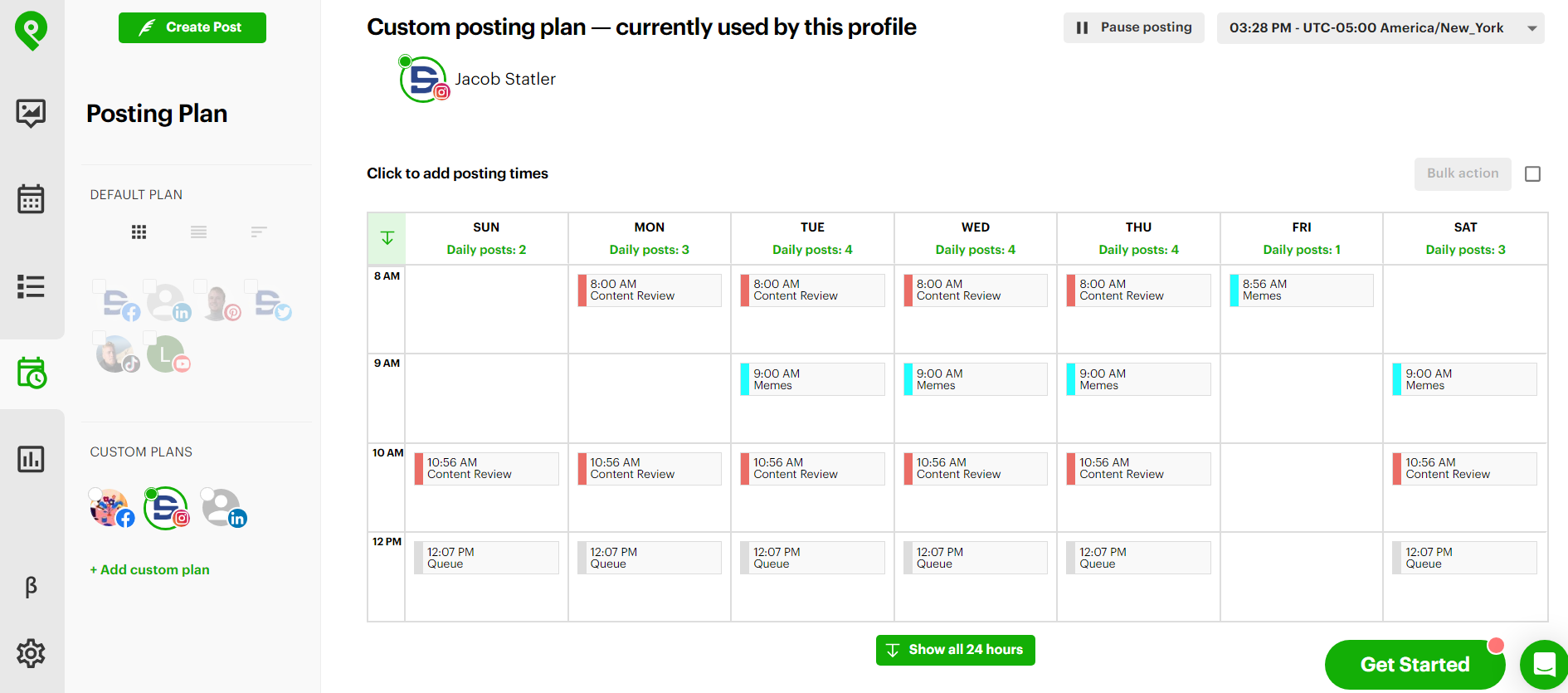
Step 2. Find curated content
Post Planner’s Content Streams are an INCREDIBLE time saver.
Content Streams can find THOUSANDS of content pieces for you across your chosen categories.
All you have to do is search for the topic you want to curate content around, then see what Content Streams have already been created about that niche.

You can easily combine your favorite creators into a new Content Stream for future use.
Step 3. Schedule content
As you find content, click on it to add it to your Content Composer. You can even click on multiple posts to add them simultaneously.

Now, click the “Create X posts” button to go to the Content Composer, where you’ll edit your content and schedule it for posting.
Step 3. Use Post Planner’s AI tools to create & optimize your content
Now that you’ve added some posts to your Content Composer, you can use AI tools to help you create and optimize text for your new posts.
Just input your prompt and tell Post Planner how many variations to generate. It’ll then output various suggestions for your post based on the type of content that performs well on social media.
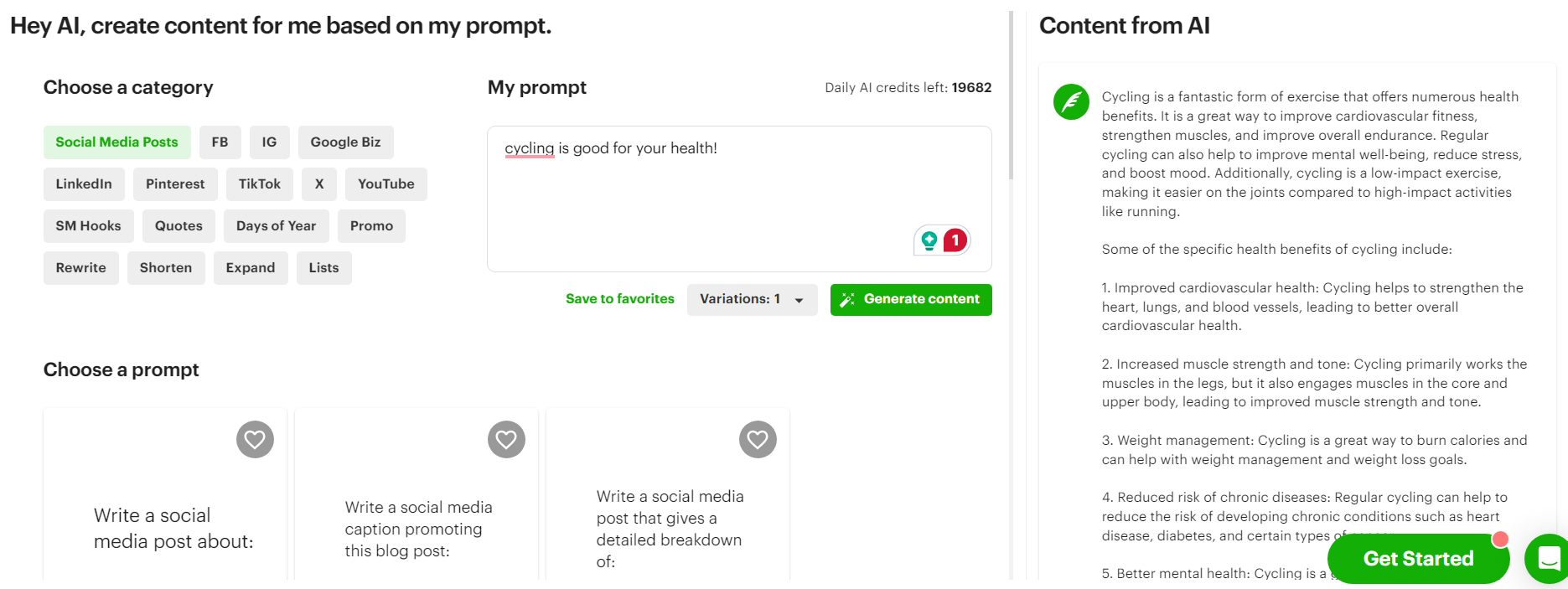
When you find AI text you like, copy it into the Content Composer. Post Planner will automatically auto-populate each post’s text field with the AI-generated content, allowing you to optimize the text for each channel.

Finally, you can take your new AI-generated content and allow Post Planner to generate a list of suggested hashtags based on your keywords for that piece of content.
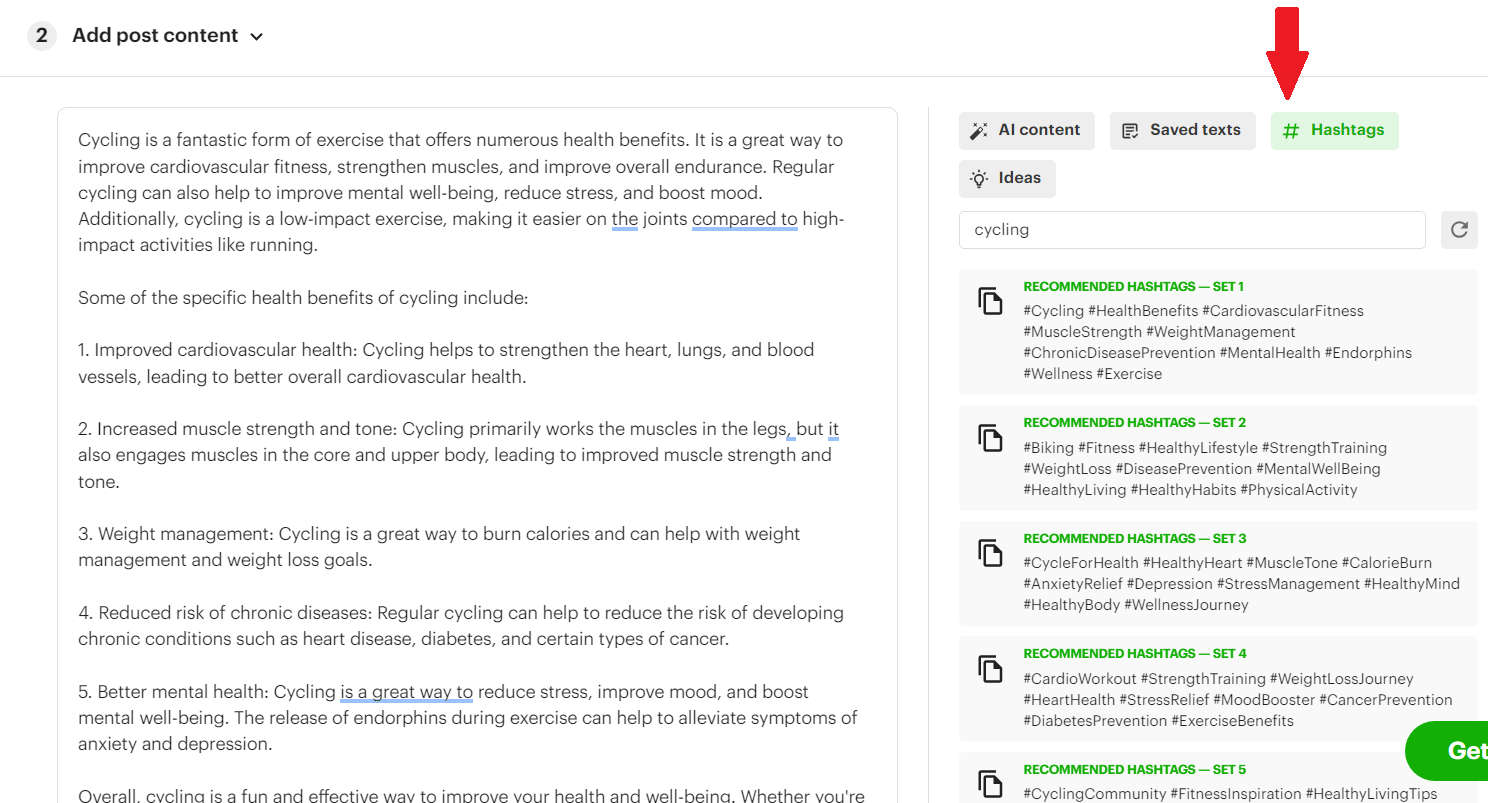
Step 5. Recycle evergreen content
As we discussed earlier, reposting your highest-performing evergreen content is a great way to improve engagement and get the most out of your posts while saving time.
To recycle content in Post Planner, go to the history tab and find the content that performed the best by looking at the analytics.

When you find something you want to repost, click the 3 dots next to the post and click “Re-queue.”
That’s all there is to it! Post Planner will ensure that your post gets added to your schedule at the right spot according to the preferences you created in Step 1.
Step 6. Evaluate your posts’ success
Speaking of the History tab, this is the best location to learn more about your audience based on the performance of your previous posts.
As shown above, you can use the History tab to see exactly how much engagement each post got. You can then compare engagement to when it was posted to improve your posting times.
Regularly evaluating your content’s success in the History tab will help you tailor your content more to your audience’s needs. Ultimately, this practice will improve your engagement and help you reach your social media goals.
FAQ
What is a social media content strategy?
A social media content strategy is just a strategic way of approaching content online. Instead of guessing what content your audience might like, you use research and investigation to discover exactly what your ICP needs, and then you create content to match.
What should be included in a content plan?
Your content plan should include:
- Content topics
- Posting times
- Content to be posted at each time
- CTAs for each post
- A mix of curated and owned content
- Specific plans for creating varied and engaging content based on your ICP
Ready to automate your social media content plan?
The tips in this post will help you create a social media plan that WORKS for you!
Remember, social media success doesn't happen overnight.
But the long-term benefits for your business are well worth the time spent!
Are you ready to rock on social media? Sign up for a Post Planner account today!







ViewHide comments (14)